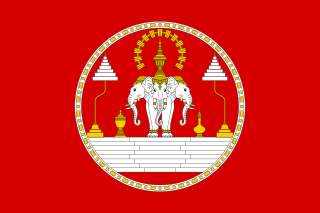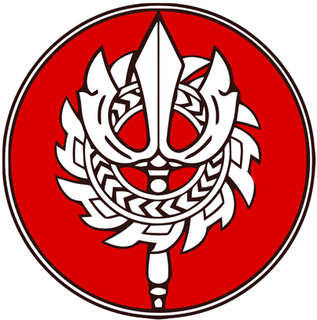Major General Phoumi Nosavan was a military strongman who was prominent in the history of the Kingdom of Laos; at times, he dominated its political life to the point of being a virtual dictator. He was born in Savannakhet, the French Protectorate of Laos, on 27 January 1920. Originally a civil servant in the French colonial administration of Laos, during the last year of World War II he joined the resistance movement against the Japanese occupiers. Exiled from 1946 to early 1949 for his opposition to French return to colonizing Laos, he returned to his native soil to begin a military career in 1950 after the collapse of the anti-French Lao Issara government. By 1955, he was Chief of Staff of the brand-new Royal Lao Army. While in that position, he was largely responsible for appointing senior officers into command positions in the Military Regions of Laos. Following that, in 1957 he was the first Lao officer to be schooled in France at the École de Guerre. While in France, he became acquainted with Central Intelligence Agency operative John F. "Jack" Hasey. Phoumi returned to Laos to become a founding member of the Committee for the Defence of National Interests on 17 June 1958. On 25 December 1959, he took control of the capital of Vientiane and of the nation in a bloodless coup.

Captain Kong Le was a paratrooper in the Royal Lao Army. He led the premier unit of the Royal Lao Army, Bataillon Parachutistes 2, which campaigned relentlessly during 1959 and 1960. The idealistic young American-trained Lao Theung officer became known worldwide when on 10 August 1960 he and his mutinous paratroopers overthrew the Royal Lao Government in a coup d'état. He declared he aimed at an end to government corruption; to the shock of American officials, he declared U.S. policies were responsible for the ongoing fraud.
The Programs Evaluation Office was a covert paramilitary mission to the Kingdom of Laos, established on 13 December 1955 by the United States Department of Defense. The 23 July 1962 International Agreement on the Neutrality of Laos would cause it to be shut down in September 1962. It would be succeeded by the Requirements Office.
The Committee for the Defence of National Interests was an anti-communist right-wing political party founded in the Kingdom of Laos on 17 June 1958. Dismayed by the election of Lao communists to the National Assembly in the May 1958 elections, younger politicians and military officers founded CDNI as an alternative to older Lao politicians and senior officers then in power. The CDNI pronounced itself as a force for anti-corruption efforts in the Royal Lao Government. It was backed by the United States embassy; American support was manifested in political advice and civic actions such as Operation Booster Shot. In the 24 April 1960 elections, which were obviously rigged, the CDNI won 32 of 59 seats. The Pathet Lao leadership had been detained during the election; on 23 May 1960, they escaped to join their insurrection in the mountains. This ended the governing coalition, and fighting began in the Laotian Civil War.
The Auto Defense de Choc company basic training program was a short intensive course in military tactics; it was developed at the start of the Laotian Civil War to begin a guerrilla movement in Laos. The ADC training that took place in the face of the North Vietnamese and Pathet Lao communist troops was so successful it was copied elsewhere, including Operation Pincushion in Laos, and among the Degar of South Vietnam. The ADC program consisted of prepacked military equipment suitable for training 100 recruits at a time.
Operation Momentum was a guerrilla training program during the Laotian Civil War. This Central Intelligence Agency operation raising a guerrilla force of Hmong hill-tribesmen in northeastern Laos was planned by James William Lair and carried out by the Thai Police Aerial Reinforcement Unit. Begun on 17 January 1961, the three-day Auto Defense Choc course graduated a clandestine guerrilla army of 5,000 warriors by 1 May, and of 9,000 by August. It scored its first success the day after the first ADC company graduated, on 21 January 1961, when 20 ADC troopers ambushed and killed 15 Pathet Lao.
Operation Hardnose was a Central Intelligence Agency-run espionage operation spying upon the Ho Chi Minh trail that began during the Laotian Civil War. Started in Summer 1963, it soon attracted the attention of the U.S. Secretary of Defense, Robert McNamara. By December 1963, he was calling for its expansion. Operation Hardnose expanded and continued to report on the Ho Chi Minh trail even as American military intelligence activities mounted against the communist supply artery. In an attempt to adapt technology for use by illiterate Lao Theung, some of the U.S. Air Force's survival radios were modified by the CIA for use by their spies.
The 1960 Laotian coups brought about a pivotal change of government in the Kingdom of Laos. General Phoumi Nosavan established himself as the strongman running Laos in a bloodless coup on 25 December 1959. He would be himself overthrown on 10 August 1960 by the young paratrooper captain who had backed him in the 1959 coup. When Captain Kong Le impressed the American officials underwriting Laos as a potential communist, they backed Phoumi's return to power in November and December 1960. In turn, the Soviets backed Kong Le as their proxy in this Cold War standoff. After the Battle of Vientiane ended in his defeat, Kong Le withdrew northward to the strategic Plain of Jars on 16 December 1960.
General Sang Kittirath was a prominent military leader during the Laotian Civil War in the Kingdom of Laos. Between January 1955 and January 1965, he was successively the commander of Military Region 2 and head of the Ground Forces Command. His performance as commander of the losing side at the Battle of Lak Sao in early 1964, plus the loss of support from its political patron Major-General Phoumi Nosavan, led to Sang's resignation from command.
Kou Kiet was a major Laotian Civil War victory for the anti-communist troops of the Kingdom of Laos. Patterned after prior Operation Raindance, it depended upon extensive air strikes blasting communist units and clearing them from the path of the Royalist offensive. Powered by 150 daylight and 50 night sorties daily, with 50 to 80 day strikes directed by Raven Forward Air Controllers, Kou Kiet ran from 6 August to 30 September 1969. It was successful beyond expectations. After the Royal Lao Government troops achieved their objectives, General Vang Pao insisted on pushing forward while they had the initiative. As a result, the Royalists regained control of the entire Plain of Jars while also capturing a huge stock of munitions from the communists. Their triumph came at a cost. However successful the Royalists were, by battle's end their battle-worn forces had exhausted their pool of potential recruits, while the Vietnamese could easily replace their personnel losses.
Operation Maeng Da was a Royal Lao Government military offensive aimed at disrupting the crucial communist supply route of the Second Indochina War, the Ho Chi Minh trail. Launched from a rendezvous point near Vang Tai, Laos, on 2 July 1970 as a three-battalion assault on the major People's Army of Vietnam (PAVN) transshipment center at Tchepone, Laos, it ran into stiff resistance from the PAVN 9th Regiment from 11–15 July. An attempt on 16 July to reinforce the Royalist Blue, Black, and Mobile 1 battalions by White Battalion was thwarted by PAVN ground fire and hazardously heavy air traffic over the battlefield. On 17 July, the worst hit Royalist unit, Black Battalion, was airlifted back out of battle. The other two Royalist battalions exfiltrated away from the PAVN troops. In the process, the commander of Mobile 1 was killed; the battalion lost all combat discipline. Both retreating battalions regrouped at the operation's start point. Although ancillary follow-up operations occurred in the vicinity throughout September, the Maeng Da offensive would not resume. However, the Central Intelligence Agency, which had trained and supported the Royalist guerrilla battalions, prepared the Tchepone Operation to follow it.
Campaign 139 was a major military offensive of the People's Army of Vietnam, launched against its Royalist enemies during the Laotian Civil War. Larger than previous invading forces, Campaign 139 was also a combined arms expedition containing tanks, artillery, engineers, and Dac Cong sappers. As such, it was a decided escalation in the war. It was also an exceptional rainy season offensive by PAVN, which usually withdrew during the wet season.
Operation Counterpunch, waged 26 September 1970 to 7 January 1971, was a military offensive of the Laotian Civil War. Royalist General Vang Pao's guerrilla army regained the vital all-weather forward fighter base at Muang Soui on the Plain of Jars from the People's Army of Vietnam (PAVN). The preemptive Counterpunch was credited with delaying an imminent PAVN wet season offensive for a month. The guerrilla army survived, though still heavily outnumbered by the PAVN.
Project Copper was a coordinated military action undertaken by the Kingdom of Laos and the Khmer Republic from 1 January–May 1971. It used U.S. Department of Defense (DOD) funds channeled through the Central Intelligence Agency to train three Cambodian battalions to interdict the Sihanouk Trail before it joined the Ho Chi Minh Trail. Committed to battle in southern Laos on 1 January 1971, one battalion deserted the battlefield, a second one mutinied during training, and a third had to be repurposed after suffering 80 casualties. By late January, the project was temporarily suspended.
Operation Phalat was a military offensive of the Laotian Civil War aimed at an active defense of the Kingdom of Thailand's northern border with the Kingdom of Laos. Evoked by the approach of The Chinese Road, and despite feeble cooperation from the Royal Lao Government, the Thai military established a three-battalion presence on Lao territory south of the Mekong River as a defense against potential invasion by the People's Republic of China.
Operation Strength II was a Royalist military offensive of the Laotian Civil War. It was devised as another diversion in the mode of the original Operation Strength. Planned as a pincer movement on the Plain of Jars, Operation Strength II's beginning was grossly hampered by combat refusals and desertions from one of its two task forces. Loss of tactical air support as the Easter Offensive began in South Vietnam also weakened the Laotian effort. In any event, neither pincer did much toward its goal of distracting the People's Army of Vietnam from its attempts to overrun the strategic guerrilla base at Long Tieng and end the war.
Operation Black Lion was a Royal Lao Government counter-offensive against a People's Army of Vietnam thrust that cut the Kingdom of Laos in two at Khong Sedone during May 1972. Two regiments of Royalist military irregulars retaliated on 15 June 1972, attacking the Communist 39th Regiment in an air assault while Royal Lao Air Force tactical air strikes hammered the 39th. During the next month, the 39th Regiment would suffer an estimated 360 casualties and be rendered ineffective for attacks. On 18 July, they retreated, leaving a rear guard to be overrun.
The Battles of Bouamlong came about because the valley of Bouamlong was a center of Royalist guerrilla operations during the Laotian Civil War. Located well into Communist-held territory and maintained by an air bridge, on several occasions Bouamlong served as a launching point for Royalist offensives such as Operation Raindance, Kou Kiet, Operation Counterpunch III, and Operation Strength. It was also targeted for attack by offensives by the People's Army of Vietnam during Campaign 139 and Campaign 74B. Defended by Auto Defense Choc troops led by Major Cher Pao Moua, Bouamlong held out against the Communist forces even after the War ended in a ceasefire in February 1973. There were reports of resistance into the 1990s.











